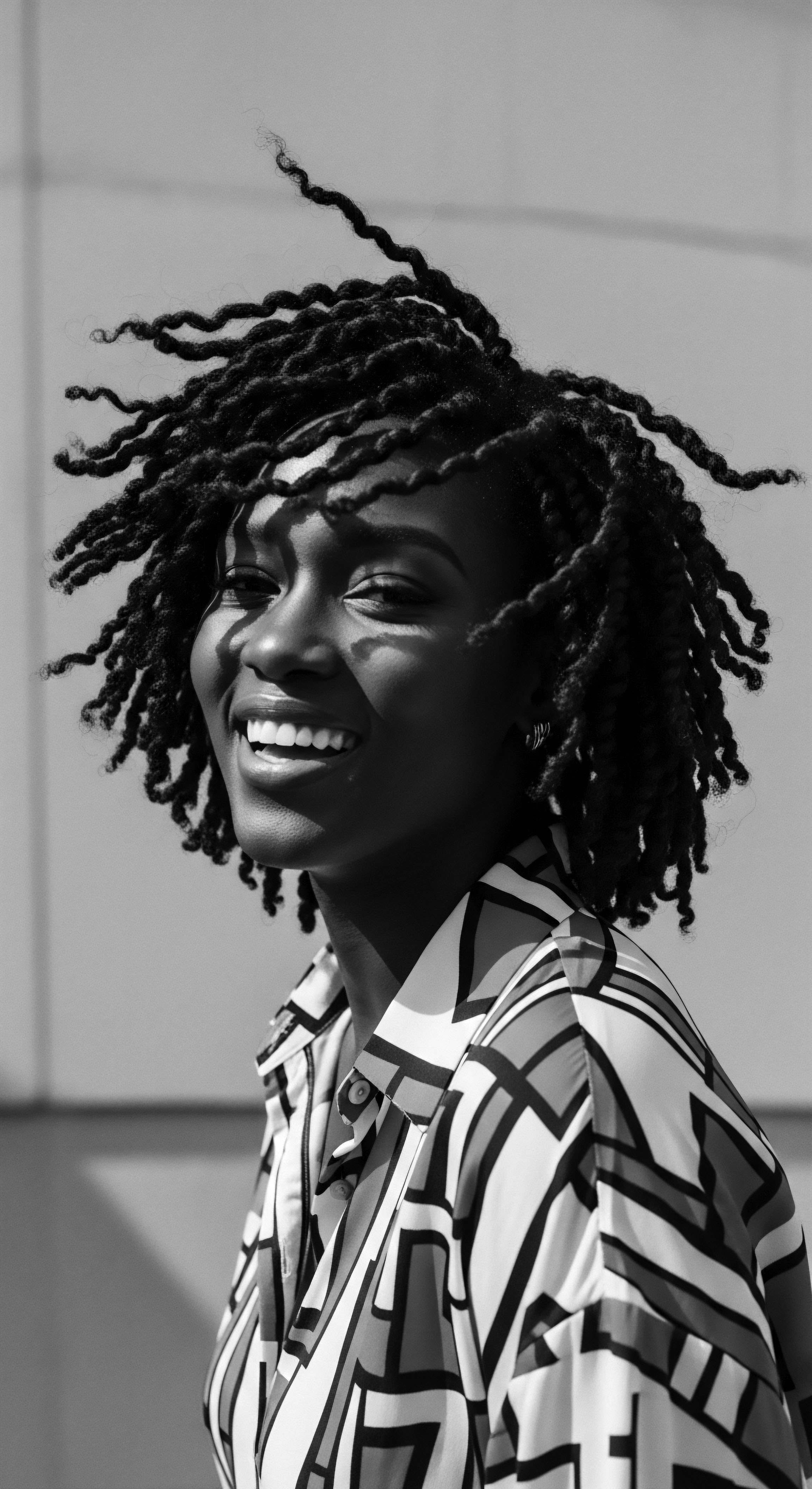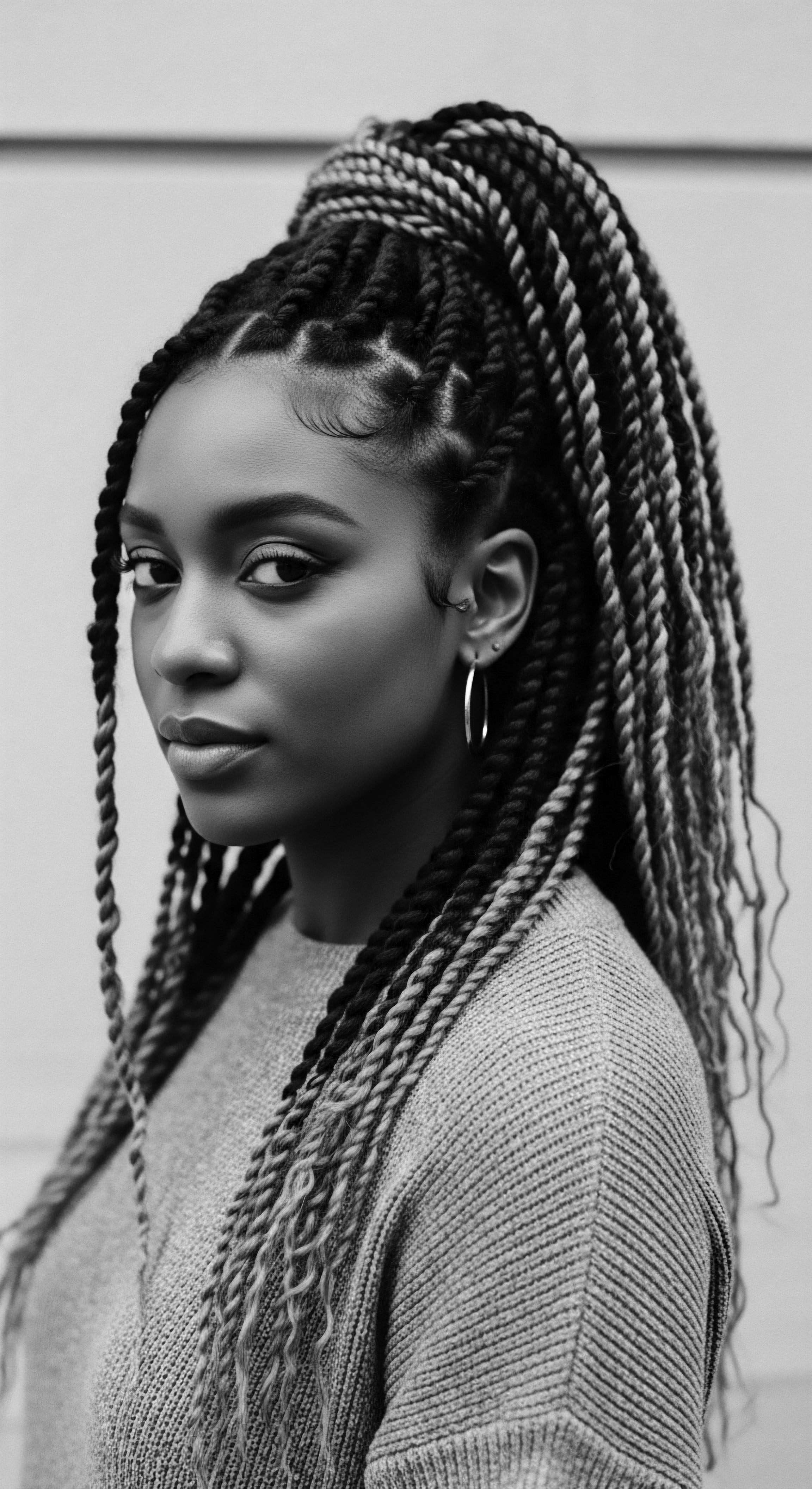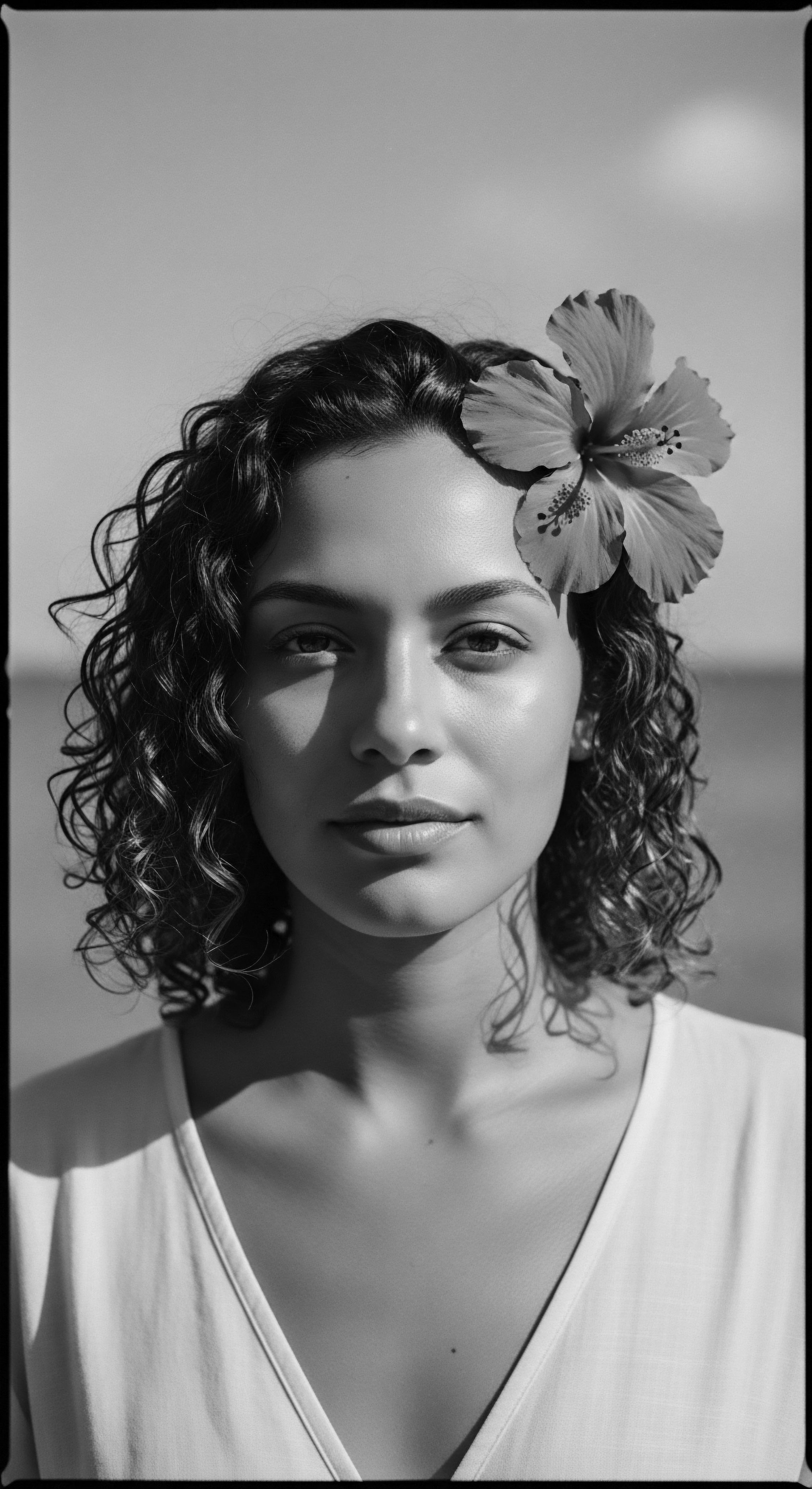The ancient world, a canvas of ingenuity and deep connection to the earth, whispers stories of heritage through every artifact, every unearthed fragment. For those of us whose hair carries the memory of coiled strength and boundless spirit, these whispers often speak of profound wisdom, particularly concerning the use of the earth’s gifts. Among these gifts, clay stands as a silent sentinel, a witness to the ancestral hands that shaped not only vessels and dwellings but also crowns of textured hair. This journey through the past unearths how ancient societies, with their intuitive grasp of nature’s provisions, turned to clay as a medium for hair care, styling, and cultural expression, weaving its elemental properties into the very fabric of textured hair heritage.

Roots
In the quietude of our collective memory, we find echoes of a time when human lives moved in concert with the rhythms of the earth. For people across ancient civilizations, particularly those whose lineages carry the distinction of textured hair, the ground beneath their feet offered sustenance beyond simple nourishment. It offered a profound connection to wellbeing, an understanding that every element held a purpose.
Clay, in its raw, unadorned state, possessed a unique capacity to cleanse, condition, and sculpt, a secret unveiled through generations of careful observation and application. This elemental wisdom became a cornerstone of ancestral hair care, long before the advent of modern chemical compounds.

Elemental Wisdom ❉ Clay’s Ancient Touch
The earth provides a wealth of minerals, each with distinct properties. Among these, various clays—such as kaolin, bentonite, and the renowned rhassoul—were not mere dirt. They were geological gifts, each bearing a unique composition of hydrous aluminum silicates and other minerals like iron, magnesium, and calcium. Ancient communities, without the benefit of scientific instruments, understood these differences through empirical wisdom.
They observed how certain clays absorbed oils, how others softened, and how some, when mixed with water, transformed into a pliable paste ideal for working with dense, coiled hair. This intimate knowledge of geological variations allowed for tailored applications, addressing specific hair needs with remarkable precision. The practice of covering the entire body and hair in a mixture of animal fat and red ochre by the Himba women in Namibia stands as a powerful testament to this early understanding of clay’s protective qualities (Rifkin, 2012). This red ochre, a type of clay, offers a degree of protection against UV rays and acts as a mosquito repellent.

The Strand’s Ancient Canvas ❉ Textured Hair and Earth’s Gift
Textured hair, with its diverse curl patterns—from soft waves to tightly coiled strands—presents distinct care requirements. Its natural inclination to dry and its susceptibility to breakage meant that traditional approaches often prioritized moisture retention, gentle cleansing, and protection. Ancient societies discovered that certain clays, when hydrated, offered a unique solution. Their microscopic structures possessed an inherent ability to absorb excess sebum and impurities from the scalp without stripping away essential moisture, a balancing act critical for hair health.
The minerals present within these clays, though perhaps not chemically analyzed, contributed to a perceived strengthening and revitalization of the hair shaft. Consider the clay deposits found along riverbanks, often rich in these beneficial minerals. Ancient peoples, living in close proximity to such natural resources, would have had abundant access to these earth-derived compounds, integrating them seamlessly into their daily lives.

Early Connections ❉ Mineral Riches for Coils
The application of clay often went beyond simple cleansing. It became part of a holistic approach to hair wellness. Different colors of clay, stemming from varying mineral compositions, were utilized for distinct purposes. Red clays, colored by iron oxides like hematite, were used for dyeing hair and for cosmetic purposes (Chaudhri and Jain, 2009).
White clays, often sourced from areas around the Nile River, were used by ancient Egyptians for cleansing and spiritual purposes, signifying cleanliness and godliness (Greene, 2006). These distinctions in application reveal a sophisticated understanding of clay’s capabilities, an understanding passed down through generations. The inherent qualities of clay provided a natural medium for working with the unique structure of textured hair, helping to define curls and provide a gentle hold without the harshness of modern products. This elemental connection represents an enduring aspect of textured hair heritage, a wisdom etched into the very earth.
Ancient societies understood clay’s versatile properties, applying it for cleansing, conditioning, and sculpting textured hair, an elemental wisdom passed through generations.

Ritual
The application of clay in ancient societies for textured hair care was rarely a utilitarian act alone. It was often imbued with ritualistic significance, a tender thread connecting the individual to their community, their ancestors, and the spiritual world. These practices unfolded as intimate ceremonies, transforming hair care into an expression of cultural identity and collective reverence. The techniques and tools employed reflected a deep respect for both the natural material and the cherished strands it was meant to adorn and protect.

Adorning the Ancestral Crown ❉ Clay’s Stylistic Role
Across various ancient cultures, hair carried immense social and spiritual weight. It communicated status, age, marital standing, and tribal affiliation. For textured hair, which can be intricately styled, clay became a vital medium for achieving complex coiffures and protective styles. In ancient Egypt, while fat-based gels were used for styling (University of Manchester, 2007), red ochre clay was also applied for cosmetic purposes, including dyeing hair (Lambert, 2001).
This suggests clay contributed to both color and texture in ancient Egyptian hairstyles. Consider the women of the Hamer community in Ethiopia, whose elaborate hairstyles incorporate clay and butter (Mpako, Matike, Ekosse, and Ngole, 2011). This tradition shows how clay acts as a sculpting agent, allowing for the creation and preservation of intricate designs that carry social meaning. The clay, often mixed with oils or plant extracts, provided hold, added weight, and even helped to maintain moisture within the hair strands, all essential for shaping and preserving textured hair styles that could last for extended periods.

Ritualistic Preparations ❉ From Earth to Elixir
The transformation of raw clay into a workable hair preparation was itself a ritualistic process. It often involved grinding the clay, mixing it with water from sacred sources, and combining it with other natural ingredients – botanical oils, plant extracts, even animal fats. These additions were not arbitrary. Each ingredient brought its own specific benefits, whether for scent, additional conditioning, or medicinal properties.
For instance, the use of rhassoul clay, sourced from the Atlas Mountains in Morocco, has been a long-standing practice in North Africa. This clay, rich in magnesium, was traditionally mixed with rose water to create a paste for body and hair care (Obscure Histories, 2024). Such concoctions were not merely applied; they were massaged into the scalp, smoothed along the lengths of the hair, and allowed to sit, often under the warmth of the sun. This deliberate process amplified the benefits, allowing the minerals to interact with the hair and scalp, while also serving as a moment of mindfulness and connection to the earth’s bounty.

Tools of Tradition ❉ Sculpting with Clay
Working with clay on textured hair necessitated specific tools and techniques, passed down through familial lines. Hands, of course, were the primary instruments, capable of distributing the clay evenly and working it into the tightest curls. Beyond hands, combs crafted from bone, wood, or other natural materials aided in detangling and parting sections. Simple implements for mixing and storing the clay mixtures were also essential.
The application of clay often involved sectioning the hair, a practice still central to textured hair care today. By segmenting the hair, ancient practitioners ensured even distribution, maximizing the benefits of the clay. This methodical approach speaks to a deep, practical understanding of textured hair’s needs, a knowledge that transcended mere aesthetics to prioritize the integrity and health of the strands. The use of clay allowed for the creation of styles that not only held but also offered protection from environmental elements, a foundational aspect of protective styling.
| Region/Culture Ancient Egypt |
| Clay Type/Mix Red ochre clay, sometimes mixed with fat/beeswax |
| Purpose for Hair Dyeing, styling, potentially hold for intricate styles |
| Cultural Significance Symbol of wealth, status, personal grooming |
| Region/Culture Himba (Namibia) |
| Clay Type/Mix Otjize (red ochre, butterfat) |
| Purpose for Hair Cleansing, conditioning, styling, UV protection |
| Cultural Significance Identity marker, beauty standard, connection to land |
| Region/Culture Bassara/Baggara (Chad) |
| Clay Type/Mix Chébé powder (plant seed, not true clay, but similar pasty application) |
| Purpose for Hair Length retention, moisture sealing |
| Cultural Significance Ancestral beauty secret, community practice |
| Region/Culture North Africa (Rhassoul) |
| Clay Type/Mix Rhassoul clay |
| Purpose for Hair Cleansing, purifying, softening, detangling |
| Cultural Significance Ritual cleansing, part of Hammam traditions |
| Region/Culture These examples illuminate clay's role as a versatile, culturally embedded element in textured hair heritage. |

Relay
The legacy of ancient societies’ engagement with clay for textured hair persists, a continuous relay of ancestral wisdom across generations. This section analyzes the complexities of clay’s role from multiple perspectives, drawing on research and studies to illustrate the interplay of historical factors, cultural practices, and scientific understanding. The deep comprehension of these practices extends beyond surface-level observation, revealing the enduring impact of earth’s bounty on textured hair heritage.

Echoes Through Time ❉ Clay’s Legacy in Hair Care
The continuity of clay use for textured hair over millennia offers powerful evidence of its efficacy and cultural resonance. What began as an intuitive application of local resources evolved into a sophisticated array of practices. These traditions, though sometimes adapted or reinterpreted, carried within them the living memory of ancestral care. Consider the ongoing use of indigenous clays in various African communities, where they continue to serve cosmetic purposes, including application on hair (Mpako, Matike, Ekosse, and Ngole, 2011).
These enduring practices are not merely historical footnotes; they are active expressions of cultural identity and resilience. The knowledge of which clay to use, how to prepare it, and for what purpose is a communal inheritance, a living library of haircare wisdom passed from elder to youth. This generational transfer of knowledge ensures that the heritage of clay-based hair care remains vibrant, defying the pressures of modern commercial products.

Scientific Reverberations ❉ Understanding Clay’s Efficacy
Modern science now offers validation for the ancient wisdom surrounding clay. The properties of different clays, such as their high absorption capacity, are well-documented. Kaolin clay, for example, is recognized for its ability to absorb moisture and excess oil, providing a clean, voluminous appearance (Bingo Cosmetic Manufacture Ltd. 2024).
Bentonite clay is valued for its detoxifying and cleansing properties. These characteristics directly address common needs for textured hair ❉ maintaining moisture balance, removing product buildup without harsh stripping, and defining curl patterns. Studies have also revealed that the mineral composition of clays, while varying widely, still consistently provides benefits to users (Daily Maverick, 2021). The presence of minerals like magnesium, silica, and iron in clays can contribute to scalp health, supporting a favorable environment for hair growth and strength.
The ion-exchange capacities of certain smectites, for instance, are useful in adsorbing and cleaning waste substances from hair and skin (Cambridge University Press, 2024). This scientific lens allows us to appreciate the profound, practical insight of ancient practitioners, whose observations often predated chemical analysis by thousands of years.
Modern science validates ancestral wisdom, confirming clay’s absorption, mineral benefits, and cleansing properties are valuable for textured hair.
One compelling case study illustrating the deep historical and ongoing significance of clay use for textured hair comes from the Nubian people of Sudan and Egypt. Their history is intertwined with the Nile, and their cultural practices reflect a profound connection to their environment. Archaeological findings and ethnohistorical accounts indicate that Nubians, known for their distinctively coiled hair, employed various substances, including natural clays, in their hair care. While direct texts detailing specific clay use for hair among ancient Nubians are sparse, indirect evidence and contemporary practices provide compelling insights.
George A. Reisner’s excavations in Nubia, for instance, revealed pottery made with Nile clay, indicating the prevalence and accessibility of this natural resource (New York University, 2011). Although the specific application for hair was not always explicitly recorded, the cultural importance of hair and grooming in Nubian society was significant, as reflected in art and historical records (eHRAF World Cultures, 2024). More recently, research examining traditional cosmetic clays in Africa, including those used by indigenous communities, highlights how the wet clays are applied topically for cosmetic purposes
and often provide benefits related to skin and hair protection (Mpako, Matike, Ekosse, and Ngole, 2011).
The persistence of these practices among present-day communities with Nubian heritage strongly suggests a continuous lineage of clay-based hair care, adapting but retaining its ancestral roots. This continuity shows a deep historical link to practices that protected and beautified textured hair, proving that knowledge and tradition can bridge vast stretches of time.

Cultural Resilience ❉ Clay, Identity, and the Diaspora
The application of clay in ancient hair practices extends beyond physical benefits; it also speaks to deeply held cultural values and the enduring resilience of textured hair heritage. Throughout history, hair has served as a powerful marker of identity, a canvas for self-expression, and a symbol of resistance in the face of oppression. For Black and mixed-race communities, whose hair has often been subjected to scrutiny and attempts at assimilation, the remembrance and revival of ancestral practices like clay cleansing represent a powerful reclamation of heritage. The use of natural earth materials connects individuals to the land from which their ancestors originated, fostering a sense of belonging and continuity.
This connection becomes particularly resonant for diaspora communities, where rediscovering ancient practices helps to bridge geographical and historical divides. It reinforces a narrative of strength and beauty inherent in textured hair, countering colonial influences that sought to devalue it. The act of returning to natural elements, such as clay, becomes a form of self-love and cultural affirmation, a living testament to the wisdom that has survived through centuries.

Reflection
As we trace the lineage of textured hair care back to its ancient roots, we find that the humble clay holds a special place. It embodies a profound understanding of natural resources, an intuitive grasp of how the earth can nurture and adorn. This journey through history is not merely an academic exercise; it is a meditation on the Soul of a Strand, recognizing the enduring spirit that resides within each coil and curl. The story of clay and textured hair is one of heritage preserved, wisdom rediscovered, and identity reaffirmed.
From the sun-baked lands of ancient Kemet to the vibrant communities across the African continent, clay was more than a mere substance; it was a partner in the meticulous care of hair. It aided in cleansing, offered conditioning, and provided a sculpting medium for styles that carried deep social and spiritual meaning. The hands that mixed ochre with oils or prepared rhassoul for a purifying wash were not only tending to hair; they were participating in a continuum of ancestral practices, honoring a legacy of beauty and resilience.
Today, as many rediscover the power of natural ingredients and reclaim their textured hair heritage, the echoes of ancient clay rituals resonate with new significance. The desire for products that work harmoniously with textured hair, that cleanse without stripping and define without stiffening, finds a profound connection to these age-old methods. The ancestral ingenuity, born from necessity and a deep bond with the natural world, guides us toward a more holistic approach to hair care—one that recognizes the sacredness of our strands and the wisdom woven into their very being.
Our textured hair is a living archive, holding stories of resilience, creativity, and the enduring connection to our forebears. The ancient use of clay, therefore, offers not just historical insight, but a compelling invitation to honor and carry forward these traditions, allowing the soul of every strand to sing its timeless song of heritage.

References
- Bingo Cosmetic Manufacture Ltd. (2024). The History of Hair Clay ❉ A Timeless Styling Tool.
- Cambridge University Press. (2024). Clays in Cosmetics and Personal-Care Products.
- Chaudhri, A. & Jain, N. (2009). History of cosmetics. Allied Publishers.
- Daily Maverick. (2021, January 15). On the therapeutic use of clay.
- eHRAF World Cultures. (2024). Nubians – Summary.
- Greene, J. (2006). African Americans in the beauty industry ❉ From Madam C.J. Walker to the present. Chelsea House Publishers.
- Lambert, R. (2001). Cosmetic Chemistry ❉ An Introduction. The Royal Society of Chemistry.
- Mpako, N. Matike, N. Ekosse, G. E. & Ngole, V. M. (2011). Indigenous knowledge applied to the use of clays for cosmetic purposes in Africa ❉ an overview. Sabinet African Journals, 34(3), 193-200.
- New York University. (2011, March 11). Nubia ❉ Ancient Kingdoms of Africa.
- Obscure Histories. (2024, February 13). Ancient Gems ❉ A Historical Survey of African Beauty Techniques.
- Rifkin, R. F. (2012). The modern use of ochre by the Himba and Herero of Namibia ❉ an ethnographic and ethnoarchaeological study (Doctoral dissertation, University of the Witwatersrand).
- University of Manchester. (2007, September 10). Ancient Egyptian hair products.
